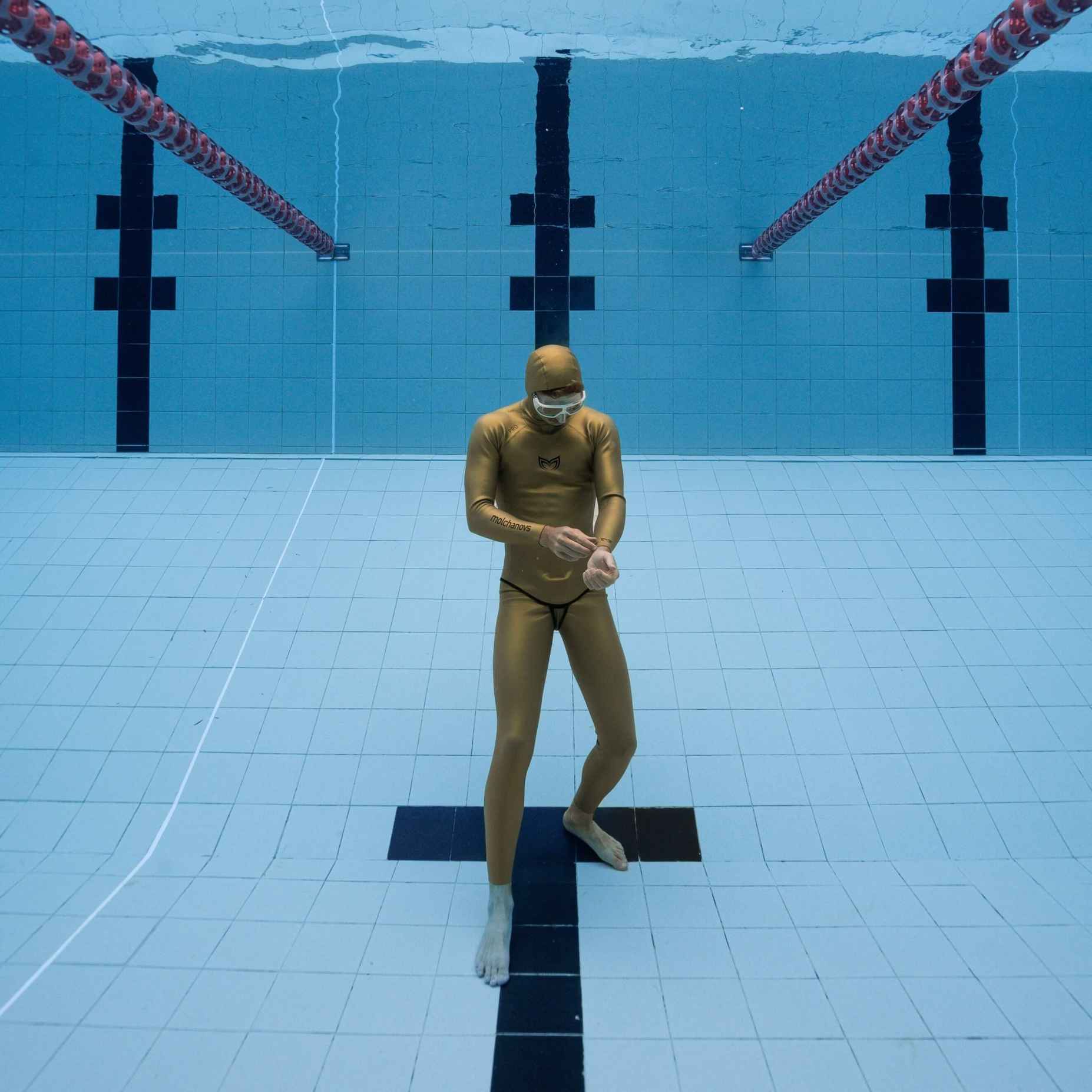Freediving Dry Training: 5 Key Areas to Work On

By Kristina Zvaritch
Contributor: Thibault Guignés
Did you know that not all freediving training has to happen in the water? That’s right - a lot of key freediving training can happen on land and with no buddy necessary! That means that even if you are landlocked and have no pool near you (or your pool does not allow freediving), your training progress does not have to be interrupted - you can dry train anywhere. So whether you are in-between freediving courses, feeling exhausted from too much in-water training, or just going through an extended dry period on land, you can still stay freediving-ready for the next time you get back in the water. So what are the 5 key areas to focus on in dry training for freediving?
Dry training in freediving involves 5 key areas: equalization, CO₂ tolerance, strength training, flexibility and mobility, and mental techniques. These 5 areas are covered in Intermediate Freediving Preparation by Matthieu Duvault, a Base Training + program that doesn’t require in-water training, equipment, or a buddy. Read on to discover what exactly you should be working on when you are confined to land.
Consider getting yourself a Molchanovs EQ Trainer, which helps you strengthen, stretch, and train the larynx and soft palate, and works to improve your Frenzel, mouthfill, and reverse packing techniques.

Learning how to visualize is introduced in the Molchanovs Lap/Wave 1 - Beginner Freediving course. Mindfulness and mindful breathing is covered in the Molchanovs Lap/Wave 2 - Advanced Freediving course. The Molchanovs Lap/Wave 3 - Master Freediving course covers attention concentration and deconcentration, while a more advanced form of these, along with mental techniques for competitions preparation, are discussed in the Molchanovs Lap/Wave 4 - Competitive Freediving course.
Learn More
Intermediate Freediving Preparation is priced at 100USD, and Molchanovs instructors and Movement members with BT access can purchase it at a discount for 80USD. Non-Movement members can receive the course at a discount by registering for Base Training Induction Online (BTIO) and becoming a Movement member. Purchase includes lifetime access to videos and training materials.
Train smart, not hard, and get direction from the experts themselves.
Contributor: Thibault Guignés
Did you know that not all freediving training has to happen in the water? That’s right - a lot of key freediving training can happen on land and with no buddy necessary! That means that even if you are landlocked and have no pool near you (or your pool does not allow freediving), your training progress does not have to be interrupted - you can dry train anywhere. So whether you are in-between freediving courses, feeling exhausted from too much in-water training, or just going through an extended dry period on land, you can still stay freediving-ready for the next time you get back in the water. So what are the 5 key areas to focus on in dry training for freediving?
Dry training in freediving involves 5 key areas: equalization, CO₂ tolerance, strength training, flexibility and mobility, and mental techniques. These 5 areas are covered in Intermediate Freediving Preparation by Matthieu Duvault, a Base Training + program that doesn’t require in-water training, equipment, or a buddy. Read on to discover what exactly you should be working on when you are confined to land.
Equalization
Sure, we can (and should!) work on equalization in the water. But let’s say you perform 10 dives, and each one is about 1 - 2 minutes. Since you are only working on equalization on the descent (let’s say you equalize 10 times in 30 seconds), that means you are only really working on equalization for a total of 5 minutes. Now on dry land, the real magic happens. You can work for 10 - 15 minutes straight on equalization, have more repetitions, and gain much better control over the necessary muscles. Plus, you can work on reducing your residual volume with empty lung stretching (must be practiced with care), which helps you not only to equalize deeper but makes equalization at shallower depths easier, too.Consider getting yourself a Molchanovs EQ Trainer, which helps you strengthen, stretch, and train the larynx and soft palate, and works to improve your Frenzel, mouthfill, and reverse packing techniques.
CO₂ Tolerance
Training CO₂ tables can definitely feel uncomfortable at first! But there’s a reason why they are such a crucial part of dry freediving training. Staying relaxed is the unofficial number 2 rule in freediving, and you must learn to relax into your contractions instead of fighting them. But instead of just doing the traditional CO₂ table for time, you can also train by counting contractions, train within the zone of ‘no contractions,’ and even performing apnea walks to switch it up.Strength
With strength comes power, and we need to be fit for freediving. However, the focus on strength training for freediving is more for lactic adaptation, which means we need to function under acidosis, or when our muscles feel heavy toward the end of a freediving performance. Options are endless: you can apnea walk (perform maximum attempts only with a buddy), apnea squats/pull-ups/push-ups/etc., apnea weight lifting with guided machines, and apnea cycling. You can also work on quadriceps/hamstrings strength for CWT and focus on triceps/biceps for FIM. Cardio will also make your heart more efficient and allow your body to use oxygen in a more energy-saving way. Just be careful not to overtrain and dehydrate your body with too much of it!Flexibility and Mobility
Flexibility and mobility are staples in a freediver’s dry training plan - as we know, yoga and freediving often go hand-in-hand! However, you can also use proprioceptive neuromuscular facilitation (a special stretching technique to improve your range of motion) to improve your amplitude in movements, general technique, efficiency, and reduce extra movements so you can save effort and energy. Body awareness, or proprioception (the ability to associate a feeling to a certain position or state of your body), can help you relax in positions you need to hold for long periods of time while also helping you to correct your technique more easily. And of course, you should sprinkle in a little uddiyana bandha to give your diaphragm some flexibility too for deeper dives!
Mental
While freediving seems like a wholly physical sport from the outside, freedivers know that it’s largely a mental sport! Luckily, a lot of the mental part of the sport can be trained in the dry. Visualizations (also called imagery), or imagining yourself performing actions the way you want to perform them in real life using all of your senses, is an effective mental technique that is used in all kinds of sports. It provides a link between the mind and body and helps with stress and motor skills. Start slow - begin with simulations and work toward full visualizations. Simulations involve performing the actions while imagining yourself performing the entire dive, making it easier to ‘stay in the dive’ in your head and keeping your thoughts from drifting away. Later, you can perform proper visualizations while breathing, where no movements or actions on your part are necessary and you simply imagine the dive and ‘feel the sensations’ in real-time.Learning how to visualize is introduced in the Molchanovs Lap/Wave 1 - Beginner Freediving course. Mindfulness and mindful breathing is covered in the Molchanovs Lap/Wave 2 - Advanced Freediving course. The Molchanovs Lap/Wave 3 - Master Freediving course covers attention concentration and deconcentration, while a more advanced form of these, along with mental techniques for competitions preparation, are discussed in the Molchanovs Lap/Wave 4 - Competitive Freediving course.
Train smart
Matthieu Duvault, a multiple Canadian National Record Holder and Molchanovs W4IT, recognized the need for a prep program between freediving courses for freedivers who have no access to water or instructors/coaches. This is why he created Intermediate Freediving Preparation, a 4-week Base Training + program that uses dry training to prepare freedivers for a Lap/Wave 2 course (or the equivalent in other agencies). He includes all of the above concepts of dry training in his Intermediate Freediving Preparation, designed to increase freedivers’ chances of passing the next-level course. His videos can be followed along in real-time, are accessible from a smartphone, tablet, or computer, and don’t require any equipment or buddies.Intermediate Freediving Preparation is priced at 100USD, and Molchanovs instructors and Movement members with BT access can purchase it at a discount for 80USD. Non-Movement members can receive the course at a discount by registering for Base Training Induction Online (BTIO) and becoming a Movement member. Purchase includes lifetime access to videos and training materials.
Train smart, not hard, and get direction from the experts themselves.





Leave a comment